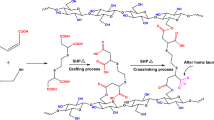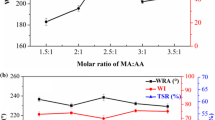Abstract
Citric acid (CA) is often used for the anti-wrinkle finishing of cotton fabrics, but it tends to yellow and undesirable anti-wrinkle effect. To solve the above problems, citric acid dimer (CACA) was synthesized by using the reaction of isocyanate with –OH in CA molecular structure, and it was used as a finishing agent for the anti-wrinkle finishing of cotton fabrics. Thermal analysis experiments demonstrated the stability of the molecular structure of CACA-HMDI and CACA-IPDI obtained from hexamethylene diisocyanate (HMDI) and isophorone diisocyanate (IPDI) respectively in the range of 20–180 °C, which reduced the yellowing of cotton fabrics caused by dehydration of CA molecular structure in high temperature curing. Under the conditions of optimal finishing process, the wrinkle recovery angle of cotton fabrics could be increased to over 270° for CACA-HMDI and 250° for CACA-IPDI, while it could only be increased to a maximum of 240° for CA. The steady-state molecular structure of CACA was analyzed by Gaussian 09W software. The calculation results of Gaussian molecular calculation software showed that compared with CACA-IPDI molecule, CACA-HMDI molecule had certain spatial folding and contained more carboxylic acid groups, which enabled it to be esterified and cross-linked at different sequencing positions of cellulose macromolecular chain, thus obtaining more effective wrinkle resistance.










Similar content being viewed by others
Data availability
The materials and data are available from the appropriate authors upon reasonable request.
References
Ahmed M, Sukumar N, Gideon RK (2021) Crease resistance finishing optimization of citric acid and fibroin solution for cotton fabrics. J Nat Fibers 18(2):297–307. https://doi.org/10.1080/15440478.2019.1623740
Arnold SR, Nelson J, Verbanc J (1957) Recent advances in isocyanate chemistry. Chem Rev 57(1):47–76. https://doi.org/10.1021/cr50013a002
Bajaj P (2002) Finishing of textile materials. J Appl Polym Sci 83(3):631–659. https://doi.org/10.1002/app.2262
Baruah R, Yadav A, Moni Das A (2022) Evaluation of the multifunctional activity of silver bionanocomposites in environmental remediation and inhibition of the growth of multidrug-resistant pathogens. New J Chem 46(21):10128–10153. https://doi.org/10.1039/D1NJ06198D
Belmonte P et al (2023) Synthesis and supercritical CO2 foaming of thermoplastic polythiourethanes with different hard segment content. J CO2 Utilization 71:102475. https://doi.org/10.1016/j.jcou.2023.102475
Caraculacu AA, Coseri S (2001) Isocyanates in polyaddition processes. Structure and reaction mechanisms. Prog Polym Sci 26(5):799–851. https://doi.org/10.1016/S0079-6700(00)00033-2
Chung Y-S, Lee K-K, Kim J-W (1998) Durable press and antimicrobial finishing of cotton fabrics with a citric acid and chitosan treatment. Text Res J 68(10):772–775. https://doi.org/10.1177/004051759806801011
Chung Y-C, Yoon H, Choi JW, Chun BC (2015) Citric acid grafting onto polyurethane for the control of molecular interactions and water compatibility. J Elastomers Plast 48(8):691–710. https://doi.org/10.1177/0095244315613623
Das A, Mahanwar P (2020) A brief discussion on advances in polyurethane applications. Adv Ind Eng Polym Res 3(3):93–101. https://doi.org/10.1016/j.aiepr.2020.07.002
Delebecq E, Pascault J-P, Boutevin B, Ganachaud F (2013) On the versatility of urethane/urea bonds: reversibility, blocked isocyanate, and non-isocyanate polyurethane. Chem Rev 113(1):80–118. https://doi.org/10.1021/cr300195n
Elmogahzy Y, Farag R (2018) 7 - Tensile properties of cotton fibers: importance, research, and limitations. In: Bunsell AR (ed) Handbook of properties of textile and technical fibres (Second Edition). Woodhead Publishing, Cambridge, pp 223–273
French AD (2017) Glucose, not cellobiose, is the repeating unit of cellulose and why that is important. Cellulose 24(11):4605–4609. https://doi.org/10.1007/s10570-017-1450-3
French AD, Johnson GP, Cramer CJ, Csonka GI (2012) Conformational analysis of cellobiose by electronic structure theories. Carbohyd Res 350:68–76. https://doi.org/10.1016/j.carres.2011.12.023
Harifi T, Montazer M (2012) Past, present and future prospects of cotton cross-linking: new insight into nano particles. Carbohyd Polym 88(4):1125–1140. https://doi.org/10.1016/j.carbpol.2012.02.017
Hashem M, Ibrahim NA, El-Shafei A, Refaie R, Hauser P (2009) An eco-friendly—novel approach for attaining wrinkle—free/soft-hand cotton fabric. Carbohyd Polym 78(4):690–703. https://doi.org/10.1016/j.carbpol.2009.06.004
Horrocks AR, Anand SC (2000) Handbook of technical textiles. Elsevier, Amsterdam
Ibrahim NA, Abo-Shosha MH, Elnagdy EI, Gaffar MA (2002) Eco-friendly durable press finishing of cellulose-containing fabrics. J Appl Polym Sci 84(12):2243–2253. https://doi.org/10.1002/app.10467
Ibrahim NA, Eid BM, Sharaf SM (2019) Functional finishes for cotton-based textiles: current situation and future trends. In: Shabbir M (ed) Textiles and clothing. Wiley, Hoboken, pp 131–190
Kozubal J, Heck TR, Metz RB (2019) Vibrational spectroscopy of Cr+(NH3)n (n = 1–6) reveals coordination and hydrogen-bonding motifs. J Phys Chem A 123(23):4929–4936. https://doi.org/10.1021/acs.jpca.9b03196
Lam YL, Kan CW, Yuen CWM (2011) Physical and chemical analysis of plasma-treated cotton fabric subjected to wrinkle-resistant finishing. Cellulose 18(2):493–503. https://doi.org/10.1007/s10570-011-9498-y
Lenzi V, Crema A, Pyrlin S, Marques L (2022) Current state and perspectives of simulation and modeling of aliphatic isocyanates and polyisocyanates. Polymers. https://doi.org/10.3390/polym14091642
Li L et al (2012) Modification of polyethersulfone hemodialysis membrane by blending citric acid grafted polyurethane and its anticoagulant activity. J Membr Sci 405–406:261–274. https://doi.org/10.1016/j.memsci.2012.03.015
Liu W, Yang S, Huang L, Xu J, Zhao N (2022) Dynamic covalent polymers enabled by reversible isocyanate chemistry. Chem Commun 58(89):12399–12417. https://doi.org/10.1039/D2CC04747K
Luo X, Shao D, Xu C, Wang Q, Gao W (2019) An eco-friendly way to whiten yellowish anti-wrinkle cotton fabrics using TBCC-activated peroxide low-temperature post-bleaching. Cellulose 26(5):3575–3588. https://doi.org/10.1007/s10570-019-02316-0
Luo X, Cheng P, Wang W, Fu J, Gao W (2021) Established an eco-friendly cotton fabric treating process with enhancing anti-wrinkle performance. J Eng Fibers Fabr 16:15589250211003454. https://doi.org/10.1177/15589250211003454
Mahmoodi NM, Masrouri O, Najafi F (2014) Synthesis of urethane sodium carboxylate and its dye removal ability from single system. J Ind Eng Chem 20(4):1558–1565. https://doi.org/10.1016/j.jiec.2013.07.047
Mohsin M, Carr CM, Rigout M (2013) Development of zero formaldehyde easy care finishing system by using nano titanium dioxide with citric acid and its impact on physical properties. Fibers and Polymers 14(9):1440–1444. https://doi.org/10.1007/s12221-013-1440-5
Niu T, Wu Y, Zhai X, Sun D, Fang L, Zhang X (2022) Investigation on multifunctional modification of cotton fabrics for salt-free dyeing, resisting crease and inhibiting bacteria. Colloids Surf, A 648:129131. https://doi.org/10.1016/j.colsurfa.2022.129131
Raj S, Sreenivasan S (2009) Total wear comfort index as an objective parameter for characterization of overall wearability of cotton fabrics. J Eng Fibers Fabr 4(4):155892500900400420. https://doi.org/10.1177/155892500900400406
Reignier J, Méchin F, Sarbu A (2021) Chemical gradients in PIR foams as probed by ATR-FTIR analysis and consequences on fire resistance. Polym Testing 93:106972. https://doi.org/10.1016/j.polymertesting.2020.106972
Rolph MS, Markowska ALJ, Warriner CN, O’Reilly RK (2016) Blocked isocyanates: from analytical and experimental considerations to non-polyurethane applications. Polym Chem 7(48):7351–7364. https://doi.org/10.1039/C6PY01776B
Sergei GE, Nesterov OV (1966) Kinetics and mechanism of the reactions. Russ Chem Rev 35(12):917. https://doi.org/10.1070/RC1966v035n12ABEH001555
Takei K-i, Takahashi R, Noguchi T (2008) Correlation between the hydrogen-bond structures and the C═O stretching frequencies of carboxylic acids as studied by density functional theory calculations: theoretical basis for interpretation of infrared bands of carboxylic groups in proteins. J Phys Chem B 112(21):6725–6731. https://doi.org/10.1021/jp801151k
Vanneste M (2015) 7 - Easy care finishes for textiles. In: Paul R (ed) Functional finishes for textiles. Woodhead Publishing, Cambridge, pp 227–256
Xu F, Yang Y, Zhang G, Zhang F, Zhang Y (2015) A self-stiffness finishing for cotton fabric with N-methylmorpholine-N-oxide. Cellulose 22(4):2837–2844. https://doi.org/10.1007/s10570-015-0686-z
Yamamoto K (1982) Crease-resistance treatments of cotton fabrics with non-formaldehyde crosslinking agents. Text Res J 52(6):357–362. https://doi.org/10.1080/15440478.2019.1623740
Yang CQ, Lan X, Shiqi L, Yanqiu J (1998) Nonformaldehyde durable press finishing of cotton fabrics by combining citric acid with polymers of maleic acid. Text Res J 68(6):457–464. https://doi.org/10.1177/004051759806800611
Yao W, Wang B, Ye T, Yang Y (2013) Durable press finishing of cotton fabrics with citric acid: enhancement of whiteness and wrinkle recovery by polyol extenders. Ind Eng Chem Res 52(46):16118–16127. https://doi.org/10.1021/ie402747x
Yeqiu L, Jinlian H, Yong Z, Zhuohong Y (2005) Surface modification of cotton fabric by grafting of polyurethane. Carbohyd Polym 61(3):276–280. https://doi.org/10.1016/j.carbpol.2005.03.010
Zhang X, Wang W, Zhu M, Yu D (2018) Wrinkle-free finishing of cotton fabrics based on click chemistry via ultraviolet radiation. J Text Inst 109(12):1536–1542. https://doi.org/10.1080/00405000.2018.1429243
Acknowledgments
The authors would like to thank the Large Instrument Management Center of the School of Chemistry and Chemical Engineering of Donghua University for consultation and instruments availability.
Funding
No funding was received.
Author information
Authors and Affiliations
Contributions
All authors contributed to the study conception and design. Data collection and analysis were performed by XZ, XY and XD. The figures were prepared by XZ and XY. The original draft of the manuscript was written by XZ and XY. All authors commented on previous versions of the manuscript.
Corresponding authors
Ethics declarations
Conflict of interest
The authors declare that they have no conflict of interest.
Ethical approval
Not applicable.
Consent for publication
All authors consent to the submission and publication of the content in this paper.
Additional information
Publisher's Note
Springer Nature remains neutral with regard to jurisdictional claims in published maps and institutional affiliations.
Rights and permissions
Springer Nature or its licensor (e.g. a society or other partner) holds exclusive rights to this article under a publishing agreement with the author(s) or other rightsholder(s); author self-archiving of the accepted manuscript version of this article is solely governed by the terms of such publishing agreement and applicable law.
About this article
Cite this article
Zhang, X., Yu, X., Dai, X. et al. Synthesis and application of citric acid dimer as the anti-wrinkle finishing agent for cotton fabric. Cellulose 31, 1985–1999 (2024). https://doi.org/10.1007/s10570-023-05716-5
Received:
Accepted:
Published:
Issue Date:
DOI: https://doi.org/10.1007/s10570-023-05716-5




